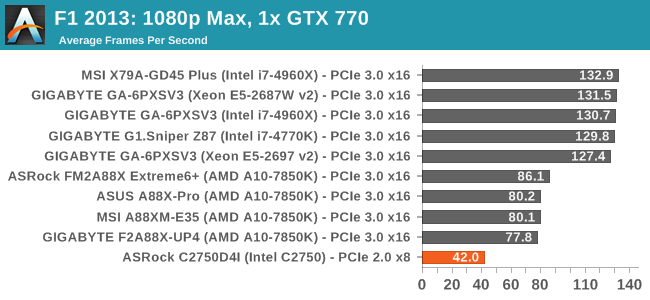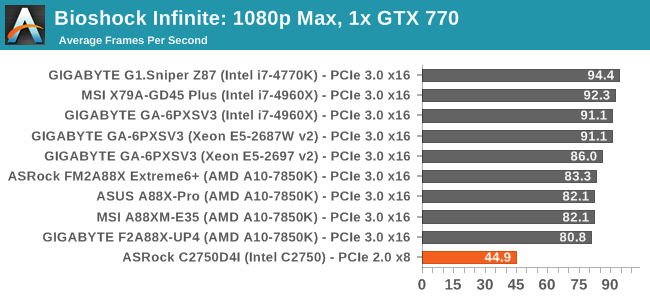ASRock Rack C2750D4I Review: A Storage Motherboard with Management
by Ian Cutress on April 29, 2014 9:00 AM EST- Posted in
- Motherboards
- Storage
- Atom
- ASRock
- Silvermont
- Enterprise
- server
- Avoton
As an interesting dynamic to our testing, it has been requested that we see how well the C2750 does in our discrete GPU benchmarks. The combination of a slower CPU and limited PCIe bandwidth will be the major culprit in almost all our benchmarks, although Tomb Raider is at least on an even keel. Most of our benchmarks show a 30+ FPS frame rate, if you are willing to pair a large GPU with the C2750D4I. Again, we are currently testing other 25W platforms to provide more applicable competition for this platform.
F1 2013
First up is F1 2013 by Codemasters. I am a big Formula 1 fan in my spare time, and nothing makes me happier than carving up the field in a Caterham, waving to the Red Bulls as I drive by (because I play on easy and take shortcuts). F1 2013 uses the EGO Engine, and like other Codemasters games ends up being very playable on old hardware quite easily. In order to beef up the benchmark a bit, we devised the following scenario for the benchmark mode: one lap of Spa-Francorchamps in the heavy wet, the benchmark follows Jenson Button in the McLaren who starts on the grid in 22nd place, with the field made up of 11 Williams cars, 5 Marussia and 5 Caterham in that order. This puts emphasis on the CPU to handle the AI in the wet, and allows for a good amount of overtaking during the automated benchmark. We test at 1920x1080 on Ultra graphical settings.

| F1 2013, 1080p Max | ||
| NVIDIA | AMD | |
| Average Frame Rates | ||
| Minimum Frame Rates | ||
Bioshock Infinite
Bioshock Infinite was Zero Punctuation’s Game of the Year for 2013, uses the Unreal Engine 3, and is designed to scale with both cores and graphical prowess. We test the benchmark using the Adrenaline benchmark tool and the Xtreme (1920x1080, Maximum) performance setting, noting down the average frame rates and the minimum frame rates.

| Bioshock Infinite, 1080p Max | ||
| NVIDIA | AMD | |
| Average Frame Rates | ||
| Minimum Frame Rates | ||
During our Bioshock Infinite test there was a clear stutter during the benchmark that would make the game completely unplayable.
Tomb Raider
The next benchmark in our test is Tomb Raider. Tomb Raider is an AMD optimized game, lauded for its use of TressFX creating dynamic hair to increase the immersion in game. Tomb Raider uses a modified version of the Crystal Engine, and enjoys raw horsepower. We test the benchmark using the Adrenaline benchmark tool and the Xtreme (1920x1080, Maximum) performance setting, noting down the average frame rates and the minimum frame rates.

| Tomb Raider, 1080p Max | ||
| NVIDIA | AMD | |
| Average Frame Rates | ||
| Minimum Frame Rates | ||
Tomb Raider is a game that seems to move almost entirely onto the GPU, not worrying much about the CPU or the DRAM attached to it.













85 Comments
View All Comments
SuperSpy00bob - Monday, May 5, 2014 - link
Oops. I it's only mentioned in the spec chart, not in the article itself. It seemed like a glaring omission.JBVertexx - Wednesday, April 30, 2014 - link
For home use, I don't know why you would pay so much for such a low-end processor. For $40 more you can have this (http://www.newegg.com/Product/Product.aspx?Item=N8... plus a Xeon E3-1230v3.I'm running a home server on an E3-1230v2 (even cheaper), and it handles storage, Plex transcoding to everyone's devices, offloaded Blu-Ray Rip transcoding, and hosts several VMs running minecraft servers for the kids. No way you could do all that with this board.
djb61 - Wednesday, April 30, 2014 - link
I've actually built a storage box recently using a fairly similar setup for a home NAS. I used the supermicro C2750 board however and added an IBM M1015 SAS card flashed to an IT mode LSI 9211-8i firmware for the disks. Then I have 8x4TB WD Reds in the Silverstone DS380.I'm still doing initial stress testing to make sure there are no dodgy disks etc currently so I can't comment about actual day to day use of such a system yet.
One thing I did notice with the DS380 is there appears to be a minor design flaw in the trays/backplane which is visible in the pictures here also.
The HDD trays have a clear perspex light guide built into the right side of them which allows an activity LED for the port on the backplane to illuminate to the front of the tray. This is the little square notch visible on the right hand side of the trays in the pictures here. However the activity light for the 4th bay from the top (5th from the bottom) doesn't illuminate on the tray properly despite it clearly lighting up on the backplane board. If you look at the picture of the backplane board and note the component labelled LED5 and its position relevant to the connector SATA13 and compare this to all the other LED and SATA components. The relative positioning on this bay is different and therefore is not aligned with the light guide on the HDD tray. I'm not quite sure how they managed to let that slip through the design stage but maybe Anandtech could feed it back to Silverstone.
azazel1024 - Thursday, May 1, 2014 - link
Why would you test power consumption in that config? It tells you nothing as it isn't remotely comparable to what it actually uses by itself or how you'd normally be using it.jwcalla - Thursday, May 1, 2014 - link
People are reporting that ASRock is pretty much treating this as a Windows-only board. If you have problems on other OSes, don't expect support from them.And with a Marvell controller... we can expect problems.
Krautmaster - Friday, May 2, 2014 - link
well, be bechmarks are a mess for a server board like this. Why not any VM benches or Storage Benches ...I used that board for Storage Tiering in Server 2013 R2 with 3x4Tb + 4x2 TB + 2x256GB SSDs see here http://www.computerbase.de/forum/showthread.php?t=...
Bronek - Sunday, May 4, 2014 - link
It's worth saying that this motherboard supports up to 64GB of ECC memory. Thanks Ian, I think you just identified parts I will need for my FreeNAS build :)copilusntil0p@ - Monday, May 5, 2014 - link
1. It's interesting how the used the PLX chipset givint tha fact that the Avoton is a SoC ant tha NICs ar integrated in it. 2. To those yelling "drop BMC": this board is not for you; don't judge it for what is not. 3. I've been in the situation to chose between this board and a Supermicro A1SRi-2758F for a home server. I've choose the latter and paired it with an HP P400 with 512MB cache and BBU (50$ on e-bay). So now I have a preety decent box with 5 gigabit interfeces, IPMI via AST2400 and 14 SATA ports (6 onboard from the SoC and eight SAS-to-SATA from the HP controller backed-up by 512MB of DDR2 cache). I've attached one Samsung 840 Pro SSD to one of the SATA 3 ports for SSD caching on ESXi. An givving the fact that the board comes from a manufacturer with greater experience in the server market, has an upgraded BMC controller, management software, wider accessory range (cases, controllers etc), has all LAN ports available, four USB 3 ports (one is directly attached to the board).LastQuark - Monday, May 5, 2014 - link
Interesting build. I thought about this route as well and since I will be using KVM, the ASRock solution is good enough for me while keeping the part count as a minimal. Have I gone to ESXi and need more ethernet ports, that Supermicro + HP solution is the way to go with only a slight penalty in power savings.dzezik - Thursday, May 8, 2014 - link
What a stupid review. Find nothing about storage performance. You used storage motherboard and stroge enclosure to test gaming performance. Who is using his NAS server for gaming?